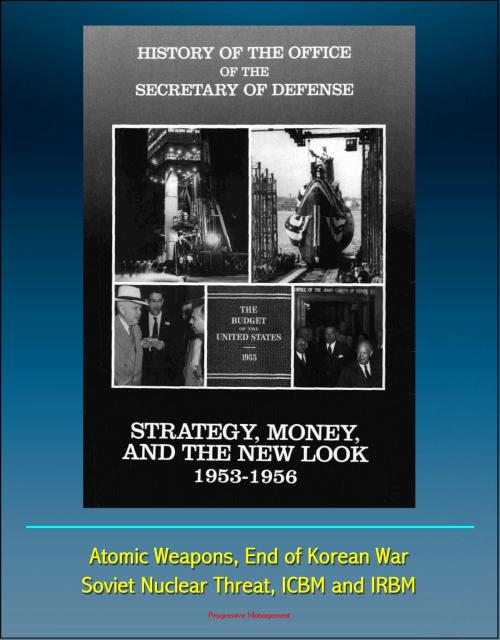History of the Office of the Secretary of Defense, Volume Three: Strategy, Money, and the New Look, 1953 - 1956 - Atomic Weapons, End of Korean War, Soviet Nuclear Threat, ICBM and IRBM
Nonfiction, History, Asian, Korean War, Military| Author: | Progressive Management | ISBN: | 9781301281183 |
| Publisher: | Progressive Management | Publication: | July 7, 2013 |
| Imprint: | Smashwords Edition | Language: | English |
| Author: | Progressive Management |
| ISBN: | 9781301281183 |
| Publisher: | Progressive Management |
| Publication: | July 7, 2013 |
| Imprint: | Smashwords Edition |
| Language: | English |
This publication, Volume III of the History of the Office of the Secretary of Defense, is concerned with the first three and a half years of the Eisenhower administration—1953-1956. The hallmark of these years was the constant struggle of the administration to hold down the cost of national defense and balance that cost against an array of post-Korea cold war challenges. For President Eisenhower the budget balancing priority was almost an obsession. His firm belief that a sound and fundamental economy was the bedrock on which all national policy had to be based manifested itself powerfully in all considerations of the national budget, and especially in the national defense budget, the dominant element. This volume, therefore, seeks to demonstrate and develop the interlocking relationship between the economy, strategy, and money in the making of a national security policy that came to be known as the New Look.
The New Look had its antecedent in the immediate pre-Korean War policies of the Truman administration, which had begun to emphasize the role of airpower and nuclear weapons in an effort to diminish reliance on the manpower-intensive ground forces and hold down the cost of national defense. The Korean War frustrated the overt implementation of this policy because of its demands for large ground forces, but important advances occurred in the buildup of strategic nuclear airpower during the war that would facilitate that transformation. Thus, for its New Look strategic air component, the Eisenhower administration inherited and embraced, within the constraints of the budget, needed essential elements—a fast-growing Strategic Air Command being equipped with jet bombers, rapidly expanding stockpiles of nuclear weapons, beginnings of ballistic missile development, and revolutionary advances in electronics. All of these could make it possible for the New Look to fulfill its widely perceived promise of a "bigger bang for a buck."
The author has organized and shaped his account of these years with the budget at the center, around which revolved issues of strategy, technology, interservice competition, and the state of the national economy This approach affords an illuminating and near-exhaustive examination of the total budget process—from the earliest planning and consideration to the final executive branch determination and through the sometimes comprehensive congressional reviews before becoming law. Strategy, Money, and the New Look offers a revealing picture not only of the key dynamic in national security decisionmaking during the Eisenhower era, but of the central and dominant role that is generally played by the budget in forming government policies.
Atomic Weapons and the End of the Korean War * I. New Bosses in the E Ring * II. Reorganizing Defense * III. Management and Budget * Hoover Commission Reforms * IV. Shrinking the Truman Budget * V. Defense Goes to Capitol Hill: The FY 1954 Budget * General Vandenberg's Day in Court * VI. Debating Defense of the Continental Vitals * Continental Defense Joins the System * VII. Economy and Strategy Decoupled: The October 1953 Budget Crisis * Redeployment, Nuclear Weapons, and the Soviet Threat * VIII. Cutting Manpower * IX. Containment's New Testament * Soviet Threat, Free World Weakness * New Emphasis on Retaliation * Reduction of the Soviet Threat * Nuclear Weapons and Redeployment * X. The New Look Takes Form * Massive Retaliation * XI. Congress and the New Look: FY 1955 * XII. Basic Strategy and the FY 1956 Budget: Pressures to Expand * XIII. Continental Defense: Ambivalence Compounded * The Growing Nuclear Threat * XIV. Basic Strategy and the FY 1956 Budget: Decision to Retrench * XV. Updating Basic National Security Policy: NSC 5501 and the Soft Line * XVI. Congress and the FY 1956 Budget * The Senate: Symington Wins One for the Marines * XVII. The 1955 Bomber Gap Flap * The Moscow Flybys
This publication, Volume III of the History of the Office of the Secretary of Defense, is concerned with the first three and a half years of the Eisenhower administration—1953-1956. The hallmark of these years was the constant struggle of the administration to hold down the cost of national defense and balance that cost against an array of post-Korea cold war challenges. For President Eisenhower the budget balancing priority was almost an obsession. His firm belief that a sound and fundamental economy was the bedrock on which all national policy had to be based manifested itself powerfully in all considerations of the national budget, and especially in the national defense budget, the dominant element. This volume, therefore, seeks to demonstrate and develop the interlocking relationship between the economy, strategy, and money in the making of a national security policy that came to be known as the New Look.
The New Look had its antecedent in the immediate pre-Korean War policies of the Truman administration, which had begun to emphasize the role of airpower and nuclear weapons in an effort to diminish reliance on the manpower-intensive ground forces and hold down the cost of national defense. The Korean War frustrated the overt implementation of this policy because of its demands for large ground forces, but important advances occurred in the buildup of strategic nuclear airpower during the war that would facilitate that transformation. Thus, for its New Look strategic air component, the Eisenhower administration inherited and embraced, within the constraints of the budget, needed essential elements—a fast-growing Strategic Air Command being equipped with jet bombers, rapidly expanding stockpiles of nuclear weapons, beginnings of ballistic missile development, and revolutionary advances in electronics. All of these could make it possible for the New Look to fulfill its widely perceived promise of a "bigger bang for a buck."
The author has organized and shaped his account of these years with the budget at the center, around which revolved issues of strategy, technology, interservice competition, and the state of the national economy This approach affords an illuminating and near-exhaustive examination of the total budget process—from the earliest planning and consideration to the final executive branch determination and through the sometimes comprehensive congressional reviews before becoming law. Strategy, Money, and the New Look offers a revealing picture not only of the key dynamic in national security decisionmaking during the Eisenhower era, but of the central and dominant role that is generally played by the budget in forming government policies.
Atomic Weapons and the End of the Korean War * I. New Bosses in the E Ring * II. Reorganizing Defense * III. Management and Budget * Hoover Commission Reforms * IV. Shrinking the Truman Budget * V. Defense Goes to Capitol Hill: The FY 1954 Budget * General Vandenberg's Day in Court * VI. Debating Defense of the Continental Vitals * Continental Defense Joins the System * VII. Economy and Strategy Decoupled: The October 1953 Budget Crisis * Redeployment, Nuclear Weapons, and the Soviet Threat * VIII. Cutting Manpower * IX. Containment's New Testament * Soviet Threat, Free World Weakness * New Emphasis on Retaliation * Reduction of the Soviet Threat * Nuclear Weapons and Redeployment * X. The New Look Takes Form * Massive Retaliation * XI. Congress and the New Look: FY 1955 * XII. Basic Strategy and the FY 1956 Budget: Pressures to Expand * XIII. Continental Defense: Ambivalence Compounded * The Growing Nuclear Threat * XIV. Basic Strategy and the FY 1956 Budget: Decision to Retrench * XV. Updating Basic National Security Policy: NSC 5501 and the Soft Line * XVI. Congress and the FY 1956 Budget * The Senate: Symington Wins One for the Marines * XVII. The 1955 Bomber Gap Flap * The Moscow Flybys















